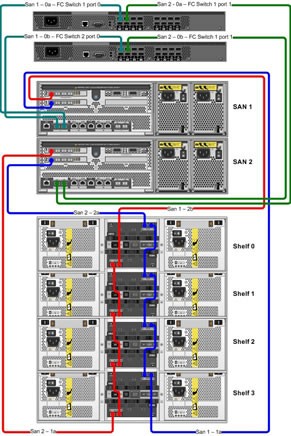
Network Appliance (NetApp)
This section is short introduction into Network Appliance (NetApp), the company creates storage systems and management software associated with companies data. They offer products that cater for small, medium and large companies and can provide support.
Other storage main vendors are
The NetApp filer also know as NetApp Fabric-Attached Storage (FAS) is a type of disk storage device which owns and controls a filesystem and present files and directories over the network, it uses an operating systems called Data ONTAP (based on FreeBSD).
NetApp Filers can offer the following
NetApp was created in 1992 by David Hitz, James Lau and Michael Malcolm, the company become public in 1995 and grew rapidly in the dot com boom, the companies headquarters are in Sunnyvale, California, US. NetApp has acquired a number of companies that helped in development of various products. The first NetApp network appliance shipped in 1993 known as a filer, this product was a new beginning in data storage architecture, the device did one task and it did it extremely well. NetApp made sure that the device was fully compatible to use industry standard hardware rather than specialized hardware. Today's NetApp products cater for small, medium and large size corporations and can be found in many blue-chip companies.
The NetApp Filer also know as NetApp Fabric-Attached Storage (FAS), is a data storage device, it can act as a SAN or as a NAS, it serves storage over a network using either file-based or block-based protocols
| File-Based Protocol | NFS, CIFS, FTP, TFTP, HTTP |
| Block-Based Protocol | Fibre Channel (FC), Fibre channel over Ethernet (FCoE), Internet SCSI (iSCSI) |
The most common NetAPP configuration consists of a filer (also known as a controller or head node) and disk enclosures (also known as shelves), the disk enclosures are connected by FC or parallel/serial ATA, the filer is then accessed by other Linux, Unix or Window servers via a network (Ethernet or FC). An example setup would be like the one in the diagram below

The filers run NetApp's own adapted operating system (based on FreeBSD) called Data ONTAP, it is highly tuned for storage-serving purposes.
All filers have a battery-backed NVRAM, which allows them to commit writes to stable storage quickly, without waiting on the disks.
It is also possible to cluster filers to create a highly-availability cluster with a private high-speed link using either FC or InfiniBand, clusters can then be grouped together under a single namespace when running in the cluster mode of the Data ONTAP 8 operating system.
The filer will be either Intel or AMD processor based computer using PCI, each filer will have a battery-backed NVRAM adaptor to log all writes for performance and to replay in the event of a server crash. The Data ONTAP operating system implements a single proprietary file-system called WAFL (Write Anywhere File Layout).
WAFL is not a filesystem in the traditional sense, but a file layout that supports very large high-performance RAID arrays (up to 100TB), it provides mechanisms that enable a variety of filesystems and technologies that want to access disk blocks. WAFL also offers
Filers offer two RAID options (see below), you can also create very large RAID arrays up to 28 disks, this depends on the type of filer.
| RAID 4 | offers single parity on a dedicated disk (unlike RAID 5) |
| RAID 6 | is the same as RAID 5 but offers double parity (more resilience), two disks in the raid could fail |
The last point to touch on is backups, NetApp offers two types
| Dump |
|
| SMTape |
|
The filer will support either SCSI or Fibre channel (FC) tape drives and can have a maximum of 64 mixed tape devices attached to a single storage system.
Network Data Management Protocol (NDMP) is a standardized protocol for controlling backup, recovery and other transfers of data between primary and secondary storage devices such as storage systems and tape libraries. This removes the need for transporting the data through the backup server itself, thus enhancing speed and removing load from the backup server. By enabling NDMP support you enable that storage system to carry communications with the NDMP-enabled commercial network-attached backup application, it also provides low-level control of tape devices and medium changers. The advantages of NDMP are